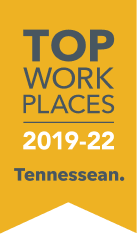Guest post contributed by Dave Scott, UX Director
Design, Test & Repeat: How We Approach UX at GS&F


The practice of User Experience (UX) is constantly growing and evolving, which can make it tough to describe. At GS&F, we’re quite familiar with helping our clients navigate the ins and outs of UX Design. Let’s dive into our process for approaching UX and walk through a tested method for delivering usable, engaging user experiences.
What is UX Design?
UX design is a process for designing digital products, apps, and websites. UX Designers have a broad range of skills across research and analysis, visual design, and technical execution. In the course of one project, our UX Designers could serve as researchers, product testers, and even talking skeleton makers.
Large product and SAAS (Software as a Service) companies may employ hundreds of UX professionals with specialized areas of focus such as UX Researcher, Strategist, Interaction Designer or UI Designer. But at GS&F, our nimble, highly skilled team of UX Designers are well-versed in leading projects throughout all aspects of the UX process. We move quickly and collaboratively, providing our clients with a pathway to starting up new experiences rapidly.
The UX Process at GS&F
If you google “UX process,” you’ll see that there are many different approaches out there. The truth is that there is no one-size-fits-all approach that works for everyone. The size of the design and development teams, complexity of the project and focus of the company can all necessitate unique UX processes. Instead of a specific “formula” to get from A to B, our process consists of three phases: Discovery, Design, and Validation.
Discovery
As the name implies, the Discovery phase of the project is focused on learning everything we can about the unique problems we are trying to solve. The goal of discovery is to identify clear business goals and KPIs, understand the needs of the users and uncover technical considerations. During this phase, we lead requirement gathering sessions, conduct qualitative and quantitative user research and uncover technical constraints alongside our development partners.
For example, when a healthcare client asked us to develop a new application to expedite patient check-in at their hospitals, our team went onsite to audit the check-in process. Direct observation helped to identify barriers that were impacting their current process.
Design
Our design phase is highly collaborative and structured around constant feedback and learning. We guide project teams through our approach and focus on adding more detail at each iteration. At the start of the design phase we create user flows and sitemaps to help drive clarity on how the users will navigate through the experience. With increased clarity, we design wireframes (black and white page mockups) to obtain feedback on content needs and prioritization. Finally, visual designs and prototypes are created to demonstrate the finished product.
Once designs are approved, our design team supports developers in bringing them to life through our agile development process. UX Designers prepare assets and documentation, answer questions and QA functionality alongside development in order to shepherd the product vision forward.
Validation
The Validation phase is essential to UX Design. During this phase, our UX Designers test the predictions that informed their designs to see whether their solutions will serve the user and the client’s needs to the fullest extent possible. User Testing, Google Analytics, Hotjar monitoring and ongoing user feedback are all vital to ensuring that the end solution is meeting the user’s needs. Validation’s goal is to identify stumbling blocks in the experience so we can tee up additional design efforts and alleviate these pain points.
For example, when working on an app for professional installers of A. O. Smith water heaters, a team member had a water heater installed at their house in order to test the connection and controls within the app through custom Bluetooth and WiFi code written by our team.

A Cyclical Process
Discovery, Design, and Validation form an ongoing framework for continued product iteration. For that reason, it’s important to consider the process a repeating circle, not a straight line. Validation efforts should feed ongoing discovery, and additional discovery efforts help to drive new designs. Our team is happy to jump into the process no matter what phase of design a product is in—whether a client has a current website they would like analysis and user feedback on or if they are kicking off a brand new app from the ground floor. As end-user advocates and UX experts, we strive to create continued value for our clients through demonstrable benefits to their customers.
Audience First—and Always Improving
Our most forward-thinking clients recognize that the digital ecosystem is constantly changing. As technologies evolve and new competitors emerge, it is important to see digital products as a continuous investment.
By aligning on an initial release, and adding features directly based on feedback from users of that product, we can help drive adoption and retention of our experiences. At GS&F, we scale our UX Design process to meet our clients’ needs and budgets, while ultimately focusing on creating memorable, usable experiences.
Ready to talk UX with us? Let’s hop on a call.
Want more of the good stuff?
Sign up to receive our articles once every few weeks, all wrapped up in a neat little email.
